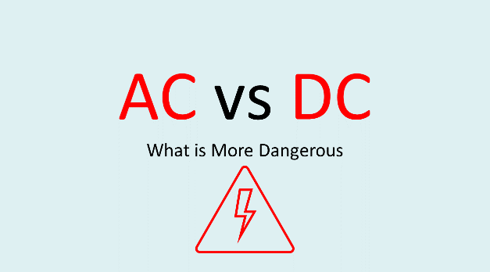AC or Alternating current changes its polarity after a specific interval of time, whereas dc always maintains its polarity. But which one is more dangerous for us: AC or DC?
Electrical current impacts our body in five different ways:
- It contracts muscles
- It causes burning
- It interferes the proper working of the nervous system
- It impacts the proper working of the heart
- It subjects the point of contact to intense heat
AC is more Dangerous Compared to DC
Compared to DC, the AC causes severe muscular contractions and simulates sweats. The wetness on skin lowers resistance, thus allowing more current to flow through.
AC electricity is often considered to be more dangerous than DC electricity for several reasons.
- Firstly, AC causes more severe muscular contractions compared to DC.
- Secondly, AC stimulates sweating, which lowers skin resistance. This is significant because resistance decreases rapidly with continued contact due to sweating, the burning away of skin oils, and even damage to the skin itself.
In the field of Electrical and Electronics Engineering, there is one popular question, that is very often asked:
“What causes harm: Current or Voltage”
The answer to this question is: Electrical current is responsible for causing harm. However, it is good to know that Ohm’s law defines the relationship between current, voltage, and resistance (I = V/R), where current is determined by the voltage divided by the resistance. However, relying solely on voltage as an indication of danger is unreliable because the body’s resistance varies significantly, making it impossible to accurately predict the amount of current flowing through the body for a given voltage.
The human body’s resistance depends on the skin’s condition at the points of contact, whether it is moist or dry. Skin resistance can range from around 1000 ohms for wet skin to over 500,000 ohms for dry skin. However, if the skin is compromised, such as through burns or a wire piercing the skin, the body’s resistance to the current decreases significantly to no more than 500 ohms. Since AC stimulates sweating and reduces the resistance of the human body, it is far more dangerous than DC, as mentioned previously.
Health and Safety Tip: It is crucial to free the victim from contact with the current as quickly as possible, without endangering oneself, to prevent the current from reaching the level that can induce fibrillation.
A note on AC Frequency
The frequency of AC also plays a role in its effects on the human body. Unfortunately, the commonly used 50 and 60-cycle frequency falls within the most harmful range. At this frequency, as little as 25 volts can be lethal. On the other hand, people have been able to withstand up to 40,000 volts at a frequency of approximately a million cycles per second without experiencing fatal effects.
Concluding Remarks
So AC is more dangerous than DC. However, both are extremely dangerous for human beings beyond a certain level. Even low voltages of AC and DC can be dangerous if the current flows through vital organs or if the duration of exposure is significant. Always stay safe and work in protected environments.
References and Further Recommended Reading
- More about “The Fatal Current” – https://www.asc.ohio-state.edu/physics/p616/safety/more_current.html
- Alternating current. (2023, July 10). In Wikipedia. https://en.wikipedia.org/wiki/Alternating_current
- Direct current. (2023, July 5). In Wikipedia. https://en.wikipedia.org/wiki/Direct_current
